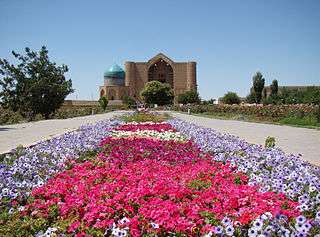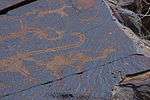List of World Heritage Sites in Kazakhstan



The United Nations Educational, Scientific and Cultural Organization (UNESCO) World Heritage Sites are places of importance to cultural or natural heritage as described in the UNESCO World Heritage Convention, established in 1972.[1] Kazakhstan accepted the convention on 29 April 1994, making its historical sites eligible for inclusion on the list; as of 2016, five sites in Kazakhstan are included.[2]
The first site in Kazakhstan, Mausoleum of Khoja Ahmed Yasawi, was inscribed on the list at the 27th Session of the World Heritage Committee, held in Paris, France in 2003.[3] Petroglyphs within the Archaeological Landscape of Tamgaly was inscribed in the following year as the second site, followed by Saryarka — Steppe and Lakes of Northern Kazakhstan in 2008.[4][5] Two transnational properties, Silk Roads: the Routes Network of Chang'an-Tianshan Corridor (shared with China and Kyrgyzstan) and Western Tien-Shan (shared with Kyrgyzstan and Uzbekistan), were added to the list respectively in 2014 and 2016.[6][7]
World Heritage Sites
The table is sortable by column by clicking on the ![]() at the top of the appropriate column; alphanumerically for the Site, Area, and Year columns; by state party for the Location column; and by criteria type for the Criteria column. Transborder sites sort at the bottom.
at the top of the appropriate column; alphanumerically for the Site, Area, and Year columns; by state party for the Location column; and by criteria type for the Criteria column. Transborder sites sort at the bottom.
- Site; named after the World Heritage Committee's official designation[8]
- Location; at city, regional, or provincial level and geocoordinates
- Criteria; as defined by the World Heritage Committee[9]
- Area; in hectares and acres. If available, the size of the buffer zone has been noted as well. A value of zero implies that no data has been published by UNESCO
- Year; during which the site was inscribed to the World Heritage List
- Description; brief information about the site, including reasons for qualifying as an endangered site, if applicable
| Site | Image | Location | Criteria | Area ha (acre) |
Year | Description |
|---|---|---|---|---|---|---|
| Mausoleum of Khoja Ahmed Yasawi |  |
South Kazakhstan 43°17′35″N 68°16′28″E / 43.29306°N 68.27444°E |
Cultural: (i)(iii)(iv) |
0.55 (1.4) | 2003 | Situated in Turkestan (formerly Yasi), the Timurid-era Mausoleum of Khoja Ahmed Yasawi remains unfinished, though it has survived as one of the largest and best-preserved examples of Timurid architecture.[10] |
| Petroglyphs within the Archaeological Landscape of Tamgaly |  |
Almaty 43°48′12″N 75°32′06″E / 43.80333°N 75.53500°E |
Cultural: (iii) |
90 (220) | 2004 | Some 5,000 petroglyphs in Tamgaly testify to the lifestyles on the central Asian steppes from the Bronze Age on.[11] |
| Saryarka — Steppe and Lakes of Northern Kazakhstan |  |
Various 50°26′00″N 69°11′20″E / 50.43333°N 69.18889°E |
Natural: (ix)(x) |
450,344 (1,112,820) | 2008 | The State Natural Reserves of Naurzum and Korgalzhyn provide sancturies for a large amount of threatened species, including Siberian white cranes, Dalmatian pelicans, Pallas's fish eagles and Saiga antelopes.[12] |
| Silk Roads: the Routes Network of Chang'an-Tianshan Corridor* | Various, shared with 34°18′16″N 108°51′26″E / 34.30444°N 108.85722°E |
Cultural: (ii)(iii)(v)(vi) |
42,668 (105,430) | 2014 | Covering a 5,000 km section of the Silk Roads, the property stretches from Chang'an in China to Zhetysu in Kazakhstan, containing historic settlements, palaces, temples, paths, fortifications, tombs and other structures.[13] | |
| Western Tien-Shan* | |
Various, shared with 43°44′00″N 68°40′44″E / 43.73333°N 68.67889°E |
Natural: (x) |
0 | 2016 | The western section of the Tian Shan mountain range system features diverse landscapes and a high degree of biodiversity.[7] |
Tentative list
In addition to sites inscribed on the World Heritage list, member states can maintain a list of tentative sites that they may consider for nomination. Nominations for the World Heritage list are only accepted if the site was previously listed on the tentative list.[14] As of 2016, Kazakhstan lists thirteen properties on its tentative list:[15]
- Turkic Sanctuary of Merke[16]
- Megalithic Mausolea of the Begazy-Dandybai Culture[17]
- Barrows with Stone Ranges of the Tasmola Culture[18]
- Petroglyphs of Eshkiolmes[19]
- Petroglyphs of Arpa-Uzen[20]
- Paleolithic Sites and Geomorphology of Karatau Mountain Range[21]
- Archaeological Sites of Otrar Oasis[22]
- Cultural Landscape of Ulytau[23]
- Northern Tyan-Shan (Ile-Alatau State National Park)[24]
- State National Natural Park "Altyn-Emel"[25]
- Aksu-Zhabagly State Natural Reserve[26]
- Western Tien-Shan[27]
- Silk Road[28]
Location of sites
References
- ↑ "The World Heritage Convention". UNESCO. Retrieved 8 August 2016.
- 1 2 "Kazakhstan". UNESCO. Retrieved 8 August 2016.
- ↑ "Report of the 27th Session of the Committee". UNESCO. Retrieved 8 August 2016.
- ↑ "Decision: 28 COM 14B.29". UNESCO. Retrieved 8 August 2016.
- ↑ "Decision: 32 COM 8B.8". UNESCO. Retrieved 8 August 2016.
- ↑ "Decision : 38 COM 8B.24". UNESCO. Retrieved 8 August 2016.
- 1 2 "Western Tien-Shan". UNESCO. Retrieved 8 August 2016.
- ↑ "World Heritage List". UNESCO. Retrieved 28 May 2010.
- ↑ "The Criteria for Selection". UNESCO. Retrieved 10 September 2011.
- ↑ "Mausoleum of Khoja Ahmed Yasawi". UNESCO. Retrieved 8 August 2016.
- ↑ "Petroglyphs within the Archaeological Landscape of Tamgaly". UNESCO. Retrieved 8 August 2016.
- ↑ "Saryarka — Steppe and Lakes of Northern Kazakhstan". UNESCO. Retrieved 8 August 2016.
- ↑ "Silk Roads: the Routes Network of Chang'an-Tianshan Corridor". UNESCO. Retrieved 8 August 2016.
- ↑ "Tentative Lists". UNESCO. Retrieved 7 October 2010.
- ↑ "Tentative List – Kazakhstan". UNESCO. Retrieved 7 August 2016.
- ↑ "Turkic Sanctuary of Merke". UNESCO. Retrieved 8 August 2016.
- ↑ "Megalithic Mausolea of the Begazy-Dandybai Culture". UNESCO. Retrieved 8 August 2016.
- ↑ "Barrows with Stone Ranges of the Tasmola Culture". UNESCO. Retrieved 8 August 2016.
- ↑ "Petroglyphs of Eshkiolmes". UNESCO. Retrieved 8 August 2016.
- ↑ "Petroglyphs of Arpa-Uzen". UNESCO. Retrieved 8 August 2016.
- ↑ "Paleolithic Sites and Geomorphology of Karatau Mountain Range". UNESCO. Retrieved 8 August 2016.
- ↑ "Archaeological Sites of Otrar Oasis". UNESCO. Retrieved 8 August 2016.
- ↑ "Cultural Landscape of Ulytau". UNESCO. Retrieved 8 August 2016.
- ↑ "Northern Tyan-Shan (Ile-Alatau State National Park)". UNESCO. Retrieved 8 August 2016.
- ↑ "State National Natural Park "Altyn-Emel"". UNESCO. Retrieved 8 August 2016.
- ↑ "Aksu-Zhabagly State Natural Reserve". UNESCO. Retrieved 8 August 2016.
- ↑ "Western Tien-Shan". UNESCO. Retrieved 8 August 2016.
- ↑ "Silk Road". UNESCO. Retrieved 8 August 2016.

